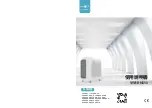
12
ELECTRIC HEAT INSTALLATION & ADJUSTMENT
This series of electric cooling and heat pump package
equipment is designed to accept a field installed electric
heat kit. The unit is equipped to easily install the HKR Series
Electric Heat Kit. Full Installation Instructions are included
in this kit. Please use this document for guidance in field
equipping the package unit with electric heat.
Choose the heat kit that fits the application for the specific
installation. Permanently mark the unit’s nameplate with the
model being installed. High and low voltage connections are
detailed in the heat kit instructions.
Indoor Blower motor speed tap selection may need to be
modified to accommodate normal continuous operation to
prevent a nuisance trip.
See table below.
Unit Model Number
5
8
10
15
20
GPC/GPH1336H21A
M
(F)
M
(F)
M
(F)
H
na
GPC/GPH1360H21A
2
(F)
2
(F)
2
(F)
2
(F)
2
(F)
H / 3 - High; M / 2 - Medium; L / 1 - Low
Speed Taps Description: H/M/L - PSC: 3/2/1 - X-13
Electric Heat KW
MAINTENANCE
WARNING
HIGH
VOLTAGE
!
D
ISCONNECT
ALL
POWER BEFORE SERVICING OR INSTALLING
THIS UNIT.
M
ULTIPLE POWER SOURCES MAY BE PRESENT. FAILU
TO DO SO MAY CAUSE PROPERTY DAMAGE, PERSONAL INJURY O
DEATH.
RE
R
The Self Contained Package Air Conditioner and Heat Pump
should operate for many years without excessive service calls
if the unit is installed properly. However it is recommended
that the homeowner inspect the unit before a seasonal start
up. The coils should be free of debris so adequate airflow is
achieved. The return and supply registers should be free of
any obstructions. The filters should be cleaned or replaced.
These few steps will help to keep the product up time to a
maximum. The Troubleshooting Chart (on page 12) should
help in identifying problems if the unit does not operate
properly.
SERVICE
THE FOLLOWING INFORMATION IS FOR USE BY
QUALIFIED SERVICE AGENCY ONLY: OTHERS SHOULD
NOT ATTEMPT TO SERVICE THIS EQUIPMENT.
Common Causes of Unsatisfactory Operation of Heat Pump
on the Heating Cycle.
Inadequate Air Volume Through Indoor Coil
When a heat pump is in the heating cycle, the indoor coil is
functioning as a condenser. The return air filter must always
be clean, and sufficient air volume must pass through the
indoor coil to prevent excessive discharge pressure, and high
pressure cut out.
Outside Air Into Return Duct
Do not introduce cold outside air into the return duct of a
heat pump installation. Do not allow air entering the indoor
coil to drop below 65° F. Air below this temperature will
cause low discharge pressure, thus low suction pressure,
and excessive defrost cycling resulting in low heating output.
It may also cause false defrosting.
Undercharge
An undercharged heat pump on the heating cycle will
cause low discharge pressure resulting in low suction
pressure and frost accumulation on the outdoor coil.
Poor “Terminating” Sensor Contact
The unit’s defrost terminating sensor must make good
thermal contact with the outdoor coil tubing. Poor contact
may not terminate the unit’s defrost cycle quickly enough
to prevent the unit from cutting out on high discharge
pressure.
Malfunctioning Reversing Valve
This may be due to:
1.
Solenoid not energized
- In order to determine if the
solenoid is energized, touch the nut that holds the solenoid
cover in place with a screwdriver. If the nut magnetically
holds the screwdriver, the solenoid is energized and the
unit is in the cooling cycle.
2.
No voltage at unit’s solenoid
- Check unit voltage. If no
voltage, check wiring circuit.
3.
Valve will not shift
:
a .
Undercharged
- check for leaks;
b.
Valve Body Damaged
- Replace valve;
c.
Unit Properly Charged
- If it is on the heating
cycle, raise the discharge pressure by restricting airflow
through the indoor coil. If the valve does not shift, tap it
lightly
on both ends with a screwdriver handle.
Do Not
Tap The Valve Body
. If the unit is on the cooling cycle,
raise the discharge pressure by restricting airflow through
the outdoor coil. If the valve does not shift after the above
attempts, cut the unit off and wait until the discharge
and suction pressure equalize, and repeat above steps.
If the valve does not shift, replace it.






































